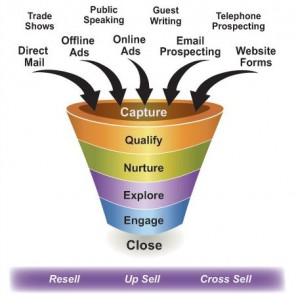 Are you familiar with the marketing funnel?
Are you familiar with the marketing funnel?
You may know it as the sales funnel or the lead funnel.
Whatever the name, I think it’s very useful graphic.
For me, it provides a good visual framework for individual marketing activities as they apply to your sales process.
Let me put it another way.
But for the most part, the focus was always on the advertising campaign.
Today, marketers have many more choices. You could almost say they have too many choices because that’s how it feels sometimes.
One way to keep track of it all is with the marketing funnel.
- A direct mail campaign or online campaign designed to capture new leads would appear at the top of the funnel (actually above the funnel).
- An email drip campaign or webinar promotion would be developed for already-captured leads inside the funnel.
- A cross-sell promotion using both email and direct mail would be developed for existing customers.
We no longer have to target everybody with the exact same campaign.
Some of these segments can vary by demographics (industry, job title, etc.), but they can also vary by stages in the sales process.
Top of the funnel is for Suspects
All of the activities you see above the funnel are lead generation activities designed to get prospects to raise their hands and show some interest in your product or service.
Top of the funnel activities tend to be the most expensive because you are often using third parties to reach these audiences – and that costs money.
Center of the funnel is for Prospects
In the traditional lead generation model, as soon as a lead was captured, it would get tossed over to sales where it would be qualified and nurtured through the sales process. And marketing was completely out of the picture.
That’s still the case with some companies, but now thanks to email, more and more companies have given marketing a larger role in the lead nurturing process.
The goal for all lead nurturing activities is to move a prospect from initial inquiry to engagement to exploration to presentation and close.
Bottom of the funnel is for Customers
For those prospects who move completely through the funnel to become customers, you can develop very specialized offers and messages to create additional sales.
- cross-selling additional products
- up-selling enhancements to an original sale
- re-selling consumable products or new versions
- A High-Wire Act for Today’s Marketers - January 28, 2021
- Is it content – or just copy? - May 26, 2020
- How you can – and why you should – use your website to teach - May 12, 2020
- How to Generate Qualified Leads with Lead Surveys - March 1, 2020
- Gaps in your Email Schedule – and how to avoid them - September 4, 2019
- The Dizzying World of Letter Mail - July 22, 2019
- Do you have an Information Kit? - June 25, 2019
- Direct Mail and Those Pesky Millennials - November 8, 2017
- Landing Pages: Do you need a squeeze page or sales page – or both? - May 31, 2017
- Do you have the patience for content and inbound marketing? - May 6, 2017


Once your prospects are in the sales cycle, it’s important to also establish a personal connection. Phone calls with sales staff and customized email interactions allow for two-way conversations to help turn prospects into customers.
Amazing.. Your Article was simply Good.. Great Research for sure and you have a awesome resource Page
Normally I don’t read article on blogs, but I would like to say that this write-up very pressured me to try and do so! Your writing style has been amazed me. Thank you, very nice post.
I was pretty pleased to discover this great site. I wanted to thank you for ones time due to this wonderful read!! I definitely liked every bit of it and I have you saved to fav to see new information in your web site.
I like your breakdown of targeted marketing tasks based on where people are at in the marketing funnel. You might have the trust needed to perform a drip email campaign on people who haven’t signed up for more info. I know I’ve heard that people need a lot of exposures to a call to action, so I can see why the funnel needs to have so many parts.
Amazing.. Your Article was simply Good..